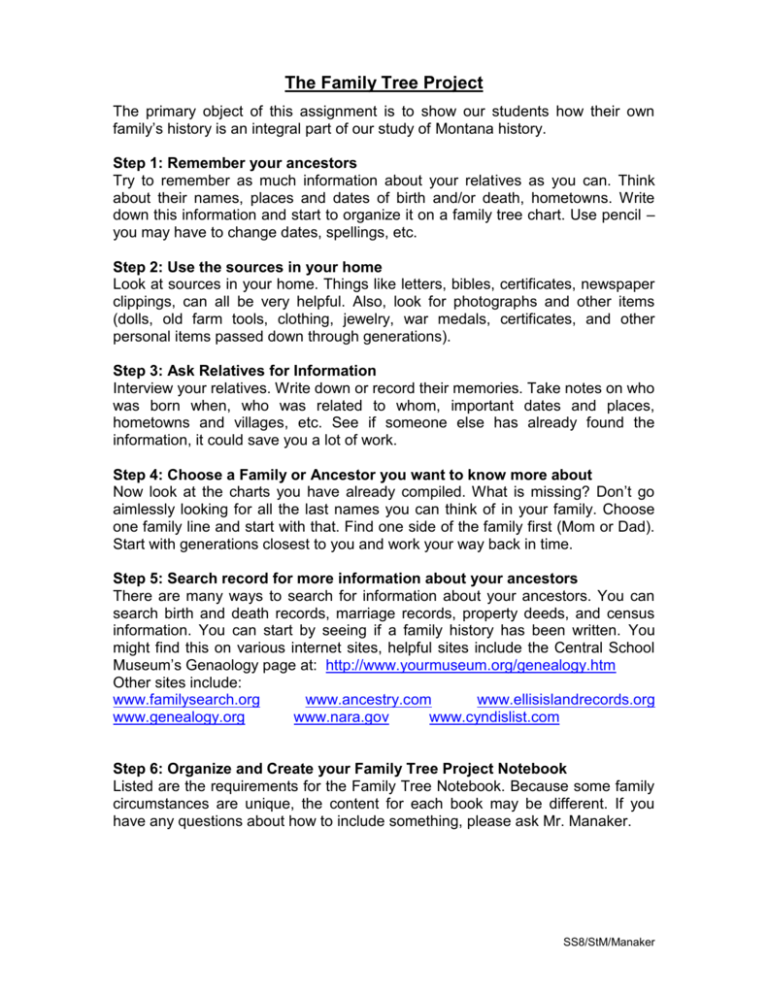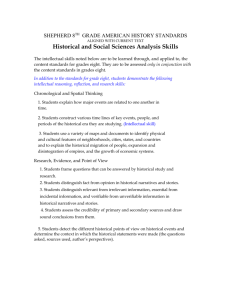Family Tree Project: Montana History Assignment
advertisement

The Family Tree Project The primary object of this assignment is to show our students how their own family’s history is an integral part of our study of Montana history. Step 1: Remember your ancestors Try to remember as much information about your relatives as you can. Think about their names, places and dates of birth and/or death, hometowns. Write down this information and start to organize it on a family tree chart. Use pencil – you may have to change dates, spellings, etc. Step 2: Use the sources in your home Look at sources in your home. Things like letters, bibles, certificates, newspaper clippings, can all be very helpful. Also, look for photographs and other items (dolls, old farm tools, clothing, jewelry, war medals, certificates, and other personal items passed down through generations). Step 3: Ask Relatives for Information Interview your relatives. Write down or record their memories. Take notes on who was born when, who was related to whom, important dates and places, hometowns and villages, etc. See if someone else has already found the information, it could save you a lot of work. Step 4: Choose a Family or Ancestor you want to know more about Now look at the charts you have already compiled. What is missing? Don’t go aimlessly looking for all the last names you can think of in your family. Choose one family line and start with that. Find one side of the family first (Mom or Dad). Start with generations closest to you and work your way back in time. Step 5: Search record for more information about your ancestors There are many ways to search for information about your ancestors. You can search birth and death records, marriage records, property deeds, and census information. You can start by seeing if a family history has been written. You might find this on various internet sites, helpful sites include the Central School Museum’s Genaology page at: http://www.yourmuseum.org/genealogy.htm Other sites include: www.familysearch.org www.ancestry.com www.ellisislandrecords.org www.genealogy.org www.nara.gov www.cyndislist.com Step 6: Organize and Create your Family Tree Project Notebook Listed are the requirements for the Family Tree Notebook. Because some family circumstances are unique, the content for each book may be different. If you have any questions about how to include something, please ask Mr. Manaker. SS8/StM/Manaker Notebook (10 points) The notebook should be done in a 3 ring binder (1/2” to 1”) and should have a decorative Notebook Cover – Cover should be neatly done and creative. Include the project rubric, and a title page with your name and date. Also include a table of contents, with all of the requirements listed below. All pages should be numbered and typed, or written in pen, on unlined paper. Personal background (10 points) Include a picture or pictures of yourself. Include as many as you can, from different periods of your life. Include a copy of your birth certificate too. Write a short, one paragraph biographical summary of yourself. Describe your immediate family, where and when you were born, and other important facts about yourself. Shield/Coat of Arms (10 points) Divided into 4 sections- include your favorite things (movies, TV, music, sports, etc.), friends and important people in your life, life accomplishments (in school and out), and your goals for the future (career, life goals, etc.) Family Origins (10 points) Find out the national origins of your family, if possible (i.e., Ireland, Poland, Nigeria, etc.) or trace the places where your family lived before settling in Montana. Write a one paragraph summary of your family origins. Then, using a map or maps of the World, United States or Montana, show the places where your family originate and lived. Family Tree (30 points) This is the family tree itself. Trace your roots back as far as you can. Use a family tree chart to show your family. Try to trace your roots back to your Great, Great Grandparents on each side of your family. Include birth and death years for the people in your tree if possible. Paternal Side (10 points) In this section, show some of the history of your father’s side of the family. Use a paragraph summary to tell about the family names and people throughout history, especially if any have been involved in historical events (wars, immigration to U.S., etc.) Show this history through pictures of the family if possible. Other suitable and interesting objects to share might be family letters, immigration, death, birth and/or marriage certificates. Other personal items could be photographed and placed in this section. Maternal Side (10 points) In this section, show some of the history of your mother’s side of the family. See Paternal Side section suggestions listed above. Summary (10 points) Picture of your family and a written summary - “What I learned from my family history project”. Include any interesting facts you may have learned, historical events your family has been a part of, etc. SS8/StM/Manaker FAMILY HISTORY PROJECT RUBRIC NAME DATE Notebook (10 points) Decorative Notebook Cover (3) Type/Pen on Unlined paper (2) Title Page (2) Table of Contents and all pages numbered (3) Personal background (10 points) Picture or pictures of yourself , birth certificate (5) Biographical summary of yourself (5) Shield/Coat of Arms (10 points) 4 sections- Favorites, People, Accomplishments, Goals (6) Colors, neatness (4) Family Origins (10 points) Summary paragraph (5) Maps (5) Family Tree (30 points) Chart showed extensive research and effort (30) Chart showed adequate research and effort (20) Chart showed incomplete research and effort (10) Paternal Side (10 points) Summary (5) Pictures, artifacts (5) Maternal Side (10 points) Summary (5) Pictures, artifacts (5) Summary (10 points) Family picture (5) Summary article (5) Total Points and Final Grade (100) SS8/StM/Manaker SS8/StM/Manaker SS8/StM/Manaker SS8/StM/Manaker SS8/StM/Manaker SS8/StM/Manaker











